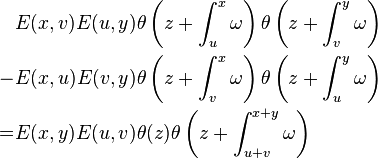Fay's trisecant identity
In algebraic geometry, Fay's trisecant identity is an identity between theta functions of Riemann surfaces introduced by Fay (1973, chapter 3, page 34, formula 45). Fay's identity holds for theta functions of Jacobians of curves, but not for theta functions of general abelian varieties.
The name "trisecant identity" refers to the geometric interpretation given by Mumford (1984, p.3.219), who used it to show that the Kummer variety of a genus g Riemann surface, given by the image of the map from the Jacobian to projective space of dimension 2g – 1 induced by theta functions of order 2, has a 4-dimensional space of trisecants.
Statement
Suppose that
- C is a compact Riemann surface
- g is the genus of C
- θ is the Riemann theta function of C, a function from Cg to C
- E is a prime form on C×C
- u,v,x,y are points of C
- z is an element of Cg
- ω is a 1-form on C with values in Cg
The Fay's identity states that

with

References
- Fay, John D. (1973), Theta functions on Riemann surfaces, Lecture Notes in Mathematics 352, Berlin, New York: Springer-Verlag, doi:10.1007/BFb0060090, ISBN 978-3-540-06517-3, MR 0335789
- Mumford, David (1974), "Prym varieties. I", in Ahlfors, Lars V.; Kra, Irwin; Nirenberg, Louis; et al., Contributions to analysis (a collection of papers dedicated to Lipman Bers), Boston, MA: Academic Press, pp. 325–350, ISBN 978-0-12-044850-0, MR 0379510
- Mumford, David (1984), Tata lectures on theta. II, Progress in Mathematics 43, Boston, MA: Birkhäuser Boston, ISBN 978-0-8176-3110-9, MR 742776
This article is issued from Wikipedia - version of the Tuesday, November 17, 2015. The text is available under the Creative Commons Attribution/Share Alike but additional terms may apply for the media files.